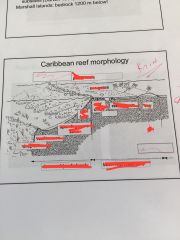![]()
![]()
![]()
Use LEFT and RIGHT arrow keys to navigate between flashcards;
Use UP and DOWN arrow keys to flip the card;
H to show hint;
A reads text to speech;
29 Cards in this Set
- Front
- Back
|
Biogenic Environments |
kelp, coral reefs, sea grasses, mangroves, sargassum |
|
|
kelp forest |
subtidal, outside 20ºC isotherms need hard substrates, most in falkland islands up to 1/2 m per day 90% becomes detritus |
|
|
keystone species in kelp forest |
sea otters; when down urchins up and kelp down (urchans eat holdfasts) |
|
|
meiofauna |
convergent worm shaped size: home of largest protists/smallest metazoans (between sand) organs for temporary attachment relatively mobile (grains shift)
|
|
|
meiofauna characteristics |
interstitial, live in water between sand convergent evolution protective armor (Scales...) k strategists |
|
|
Coral reefs essentials |
cnidaria and dinoflagellates (zooxanthellae) shallow waters, warm temps, high salinity meroplanktonic: lnaula larvae exoskeleton 103 mm around polyp GBReef 2 million, some 60 Atlantic 10,000 |
|
|
coral symbiosis |
all nutrients bound in biomass, constant recycling (low F ratio, <.1))
CO2, NH4, P from polyp Photosynthetic sugars, amino acids from algae more calcification possible with symbionts
|
|
|
coral taxonomy |
Phylum Cnidaria (nematocysts) class Anthozoa subclass Hexacorallia (hexagon symmetry) |
|
|
deep sea corals |
majority of coral species in deep dark water greatest threat deep sea trawling sea pens and sea whip/gobi (he almost discovered) |
|
|
algae in coral reefs |
Coralline (red) important in cementing reef fragments don't need a lot of light, bottom of coral |
|
|
Some Coral Reef Fish |
highly specialized Parrot fish - grasps algae from corals (sand through it)
Angel Fish, Butterfly Fish, Moray Eel, Sea/Brittle Stars, Polycheates and sponges |
|
|
Triggerfish |
coral reef fish dorsal fins lock in place (name) so that it harder to eat strongs jaws, can blow on sand dollars to expose and eat |
|
|
Surgen fish |
coral reef fish poisonous blade close to tail fin, feed on small phytoplankton, some zoo |
|
|
giant clam |
Tridacna largest bivalve mollusk, up to 400 lbs, 5 feet dinoflagellate endosymbionts zooxanthellae |
|
|
coral reef ecology |
competition for space = chemical warfare
reproduction synchronized w/ moon
feed on zooplankton with nematocysts, mucous nets
primary production by zooxanthellae, reef algae, reef phytoplankton |
|
|
coral reef formation |
fringing reef along coast
barrier reef as land sinks leaving ocean water between reef and land
atolls as island continues to subside
|
|
|
3 zones of coral reef |
reef flat (back reef): few m's deep, variations in TS
reef crest: highest point, exposed to air at Ltide
reef slope (fore reef): largest, outside of r crest; below 20 m soft corals sponges replace hard |
|

|

|
|
|
animal threat to c reef |
acanthaster planci (Crown of thorns starfish) |
|
|
mangrove swamp characteristics |
emergent vascular plants tropical/subtropical important tree genera: Red Rhizophora, black, white mangrove salty, low o2, little wave action (variable TS) high organic input low stability (on mud) physiological adaptations to salt viviparous |
|
|
mangrove formation |
sediment entrapment, 95% of leaves become part of detrital food web |
|
|
viviparous Rhizophora |
seeds germinate on trees, drop into water and dispersed |
|
|
mangrove adaptations to NaCl |
roots have membrane prevents salt entering leafs can excrete salt |
|
|
mangrove adaptations to low O2 |
oxidized sediments around roots sucked in through pneumatophores |
|
|
mangrove adaptations to soft sediment |
anchor/cable/prop roots spread far and shallow |
|
|
mangrove morphology |
fish, shrimp Htide; land mammals Ltide barnacles oysters sponges crabs on prop roots
mangroves seaward, marshes/t flats landwards |
|
|
sea grass characteristics |
flowering (underwater fertilization) vascular, need a lot of light
produce own environment, provide shade for algae
slow water movement and trap sediments leafs grow like a conveyer belt, tips get colonized and eaten
shelter large number of species |
|
|
largest sea grass |
posidonia, clear water, up to 50 M |
|
|
sea grass zonation |
upper leaf epiphytes (plant on plant) lower leaf rhizome layer sediment layer |

